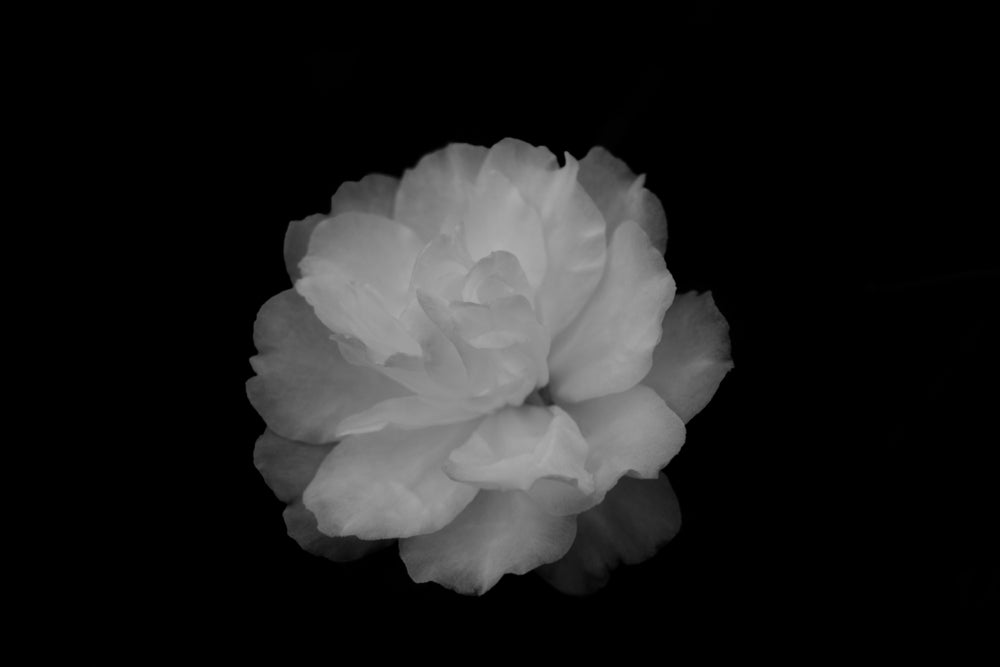
ingredient focus: camellia

the bottom line
The camellia is a legendary flower associated with luxury. But those pretty petals also hide some of the most effective components in skincare which can target photoaging, inflammation, pigmentation, and even the effects of pollution. Keep reading to learn more about the beauty behind the blossoms of the camellia flower.
first layer: the history
Camellia is a genus of flowering plants found in eastern and southern Asia, ranging from the Himalayas in the west to Japan and Indonesia in the east. Camellia sinensis leaves are used to create tea, while Camellia japonica (tsubaki) and Camellia oleifera are grown for both their ornamental, culinary, and cosmetic uses. Tea oil is a sweet cooking oil made by pressing the seeds of the Camellia japonica and Camellia oleifera flowers. Tsubaki or dongbaek oil, made from the seeds of Camellia japonica, has been traditionally used in Japan and Korea as a prized hair care ingredient.
Camellia was cultivated in the gardens of China and Japan long before it found its way to Europe in the late 18th century. It has been reported that by 1819, 25 camellias had bloomed in England. By the 1840’s, the camellia flower had reached its zenith in popularity and was considered to be the flower of luxury.
second layer: the science
While each species of Camellia has its own set of benefits, Camellia japonica or tsubaki is notable for a number of unique qualities that makes it particularly suitable for skincare, including anti-inflammatory, antioxidant*, anti-tyrosinase*, and anti-bacterial properties, as well as collagen* stimulation, suppression of matrix metalloproteinase production (MMP)*, and a decrease in transepidermal water loss (TEWL)*.
- anti-inflammatory*: Camellia japonica was shown in one study to possess 29 separate anti-inflammatory compounds, including vitamin E, squalene, and lupeol. Another study demonstrated that Camellia japonica oil exerts its anti-inflammatory effects by down-regulating the expression of inflammatory mediators including inducible nitric oxide synthase (iNOS) and cyclooxygenase-2 (COX-2).
- antioxidant*: Camellia japonica flower extract shows high antioxidant* activity and is able to inhibit urban air pollutant-induced reactive oxygen species (ROS)* generation and matrix metalloproteinase-1 (MMP-1)* production. Camellianoside is a quercetin* isolated from Camellia japonica which also demonstrates antioxidant* activity. Camellia japonica flower extract has been shown to scavenge free radicals* more effectively than vitamin C.
- anti-tyrosinase* and anti-melanocyte stimulating hormone (MSH) production: Tyrosinase is an enzyme which is the rate-determining step of melanin synthesis. Camellioside, a major constituent of Camellia japonica, shows significant inhibition of melanogenesis*. The oil itself also exhibits significant suppression of melanogenesis* by the inhibition of tyrosinase*.
- anti-bacterial: Extracts from the petals of the Camellia japonica flower inhibit the growth of specific bacteria, including Salmonella typhimurium, Escherichia coli, Listeria monocytogenes, and Staphylococcus aureus.
- collagen* stimulation: Camellia japonica oil induces type I procollagen, while camellioside A treatment has been shown to stimulate the production of Type I pro-collagen and collagen*. Camellioside B has also been shown to accelerate fibroblast* production.
- suppression of MMP-1 production: Camellia japonica oil, Camellioside A, a triterpene* saponin*, and Camellenodiol, a triterpenoid*, have all been shown to suppress MMP-1* production mediated by ultraviolet A rays.
- skin barrier protection: Camellia japonica oil contains high levels of oleic acid omega-9 and reduces TEWL*.
third layer: the benefits
Camellia japonica has been used traditionally to nourish and soothe the skin while restoring its elasticity, as well as for control of bleeding. Some specific uses of this oil include anti-aging, control of pigmentation, anti-pollution, and skin barrier protection.
Our skin is repeatedly exposed to environmental toxins, including UV radiation, pollution, and smoke. There is increasing evidence to suggest that these toxins are associated with a number of adverse effects on the skin, including inflammatory and allergic skin disorders as well as aging. UV radiation is a key factor in photoaging of the skin secondary to DNA damage and degradation of the extracellular matrix (ECM)* which occurs as a result of ECM-degrading enzymes including MMP’s*. As a result, excess collagen* degradation is induced with subsequent structural changes including loss of elasticity and strength, inflammation, and wrinkle formation. Air pollution in particular increases the production of ROS*, mitochondrial* damage, and skin aging. ROS generation mediates adverse effects on the skin including DNA damage, the induction of pro-inflammatory cytokines*, and MMP’s*.
Camellia japonica is uniquely able to combat a tremendous number of these aging and pollution effects by its anti-inflammatory* compounds and its antioxidant* properties which inhibit the generation of ROS* and MMP’s*. Its ability to stimulate both fibroblasts* and collagen* production helps to limit the formation of wrinkles and skin laxity.
Camellia japonica controls pigment formation – another by-product of aging and UV exposure – by inhibiting tyrosinase. Finally, the skin barrier is protected by this oil with its very high (75-90%) concentration of oleic acid.
fourth layer: how we do it
Camellia has played a significant role in many of our formulations. Camellia sinensis was included in our original rice & bamboo facial scrub, and Camellia oleifera is a key ingredient of our organic lip butter. our tsubaki & bakuchiol eye crème features Camellia japonica, bakuchiol, caffeine, and hyaluronic acid.
All this and more at www.anokhaskincare.com .
xx
anokha
references:
- www.wikipedia.org
- www.natureinbottle.com
- Majumder S, Ghosh A, Bhattacharya M. Natural anti-inflammatory terpenoids in Camellia japonica leaf and probable biosynthesis pathways of the metabolome. Bull Nat Res Centre 2020; 44: 141-155.
- Kim S, Jung E, Shin S, et al. Anti-inflammatory activity of Camellia japonica BMB Rep 2012; 45(3): 177-182.
- Karadeniz F, Oh JH Kim HR, Ko J, Kong CS. Camellioside A, isolated from Camellia japonica flowers, attenuates UVA-induced production of MMP-1 in HaCaT keratinocytes via suppression of MAPK activation. Exper Ther Med 2021; 21: 16-22.
- Kim M, Son D, Shin S, et al. Protective effects of Camellia japonica flower extract against urban air pollutants. BMC Comp Altern Med 2019; 19: 30-39.
- Oh JH, Nam GB, Karadeniz F, Kong CS, Ko J. Evaluation and enzyme-aided enhancement of anti-photoaging properties of Camellia japonica in UVA-irradiated keratinocytes. Z Naturforsch C J Biosci 2022; 77: 287-296.
- Jung E, Lee J, Baek J, et al. Effect of Camellia japonica oil on human type I procollagen production and skin barrier function. J Ethnopharmacol 2007; 112: 127-131.
- Nakamura S, Moriura T, Park S, et al. J Nat Prod 2012; 75: 1425-1430.
- Ha SY, Jung JY, Yang JK. Camellia japonica essential oil inhibits alpha-MSH-induced melanin production and tyrosinase activity in B16F10 melanoma cells. Evid-Based Complement Altern Med 2021; Article ID: 6328767, 8 pages.
- Choi MH, Min MJ, Oh DS, Shin HJ. Antimicrobial and antioxidant activity of Camellia japonica extracts for cosmetic applications. KSBB J 2013; 28: 99-105.
*definitions:
anti-inflammatory: an anti-inflammatory is a substance that reduces inflammation in the body.
antioxidant : an antioxidant is a compound that inhibits oxidation. free radicals create oxidative stress and an inflammatory response which in turn can damage DNA and result in injury to the epidermal and dermal layers of the skin. in the skin, this manifests as premature aging with decreased elasticity leading to increased wrinkling, age spots, and decreased skin tone. antioxidants stabilize free radicals, which in turn limits their ability to damage the body. some of our favorite ingredients are notable for their antioxidant effects, including elderberry, plum, and lychee.
anti-tyrosinase: an anti-tyrosinase blocks the enzyme tyrosinase, one of the key enzymes in the formation of melanin in the skin.
collagen : collagen is a fibrous protein that forms part of the dermal matrix, connective tissue, cartilage, and bone.
cytokine: a cytokine is a substance which is secreted by cells of the immune system and which can affect other cells.
extracellular matrix (ECM): the extracellular matrix is a three-dimensional network of extracellular macromolecules and minerals, including collagen, enzymes, proteins, and hydroxyapatite that provide structural and biochemical support to surrounding cells.
fibroblast: a fibroblast is a cell that contributes to the formation of connective tissue within the body. fibroblasts secrete collagen proteins which help to maintain the structural framework of the tissues.
free radicals : a free radical is an unstable molecule created during normal cell metabolism. free radicals can accumulate in cells in cause damage to other structures, including DNA, lipids, and proteins.
matrix metalloproteinase (MMP): matrix metalloproteinase is a member of a group of enzymes that can break proteins such as collagen. it requires zinc or calcium to work properly and is critical for wound healing. it has been implicated in premature photoaging and the development of skin cancer.
melanogenesis : melanogenesis is the process for the production of melanin, the primary source of pigmentation in the skin.
mitochondria: the mitochondria is an organelle found in most cells in which respiration and energy production occur.
quercetin: quercetin is a plant pigment found in many plants and foods, including red wine, green tea, and berries.
reactive oxygen species (ROS): reactive oxygen species are a type of unstable molecule that contains oxygen and which can easily react with other molecules in a cell. they can cause damage to DNA, RNA, proteins, and even cell death.
saponin: saponins are plant-derived organic chemicals which can foam when agitated in water.
terpenoid: terpenoids are a large class of organic chemicals. plants use terpenoid metabolites for basic functions of growth and development, as well as specialized interactions and protection within the environment.
triterpene/triterpenoids: triterpenes are a class of chemical compounds produced by animals, plants, and fungi.
transepidermal water loss (TEWL): transepidermal water loss, or TEWL, is the normal movement of water from the stratum corneum to the atmosphere.
for more beauty definitions, explore the glossary.
faq's:
what are some camellia seed oil benefits?
camellia seed oil can be used for anti-aging, control of pigmentation, anti-pollution, and skin barrier protection.
is camellia oil comedogenic?
camellia oil is non-comedogenic and does not clog pores.
how do I use camellia oil for lips?
we use organic Camellia oleifera oil as one of the key ingredients in our lip butter. it is capable of protecting the skin barrier and acts an antioxidant.
can I use camellia oil for stretch marks?
although there is no data to demonstrate that camellia oil is effective for stretch marks, it has been used for centuries with reportedly positive results.
how do I use camellia oil for wrinkles?
camellia oil has antioxidant properties which inhibit the formation of free radicals. it also promotes the formation of collagen. both of these attributes help to decrease the formation of skin wrinkles and improve skin elasticity



leave us a comment
This site is protected by hCaptcha and the hCaptcha Privacy Policy and Terms of Service apply.